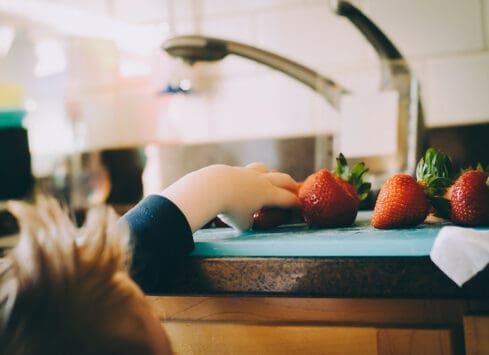Tips from a Mom: Engaging Children with ADHD in the Kitchen
“What’s for dinner? When will it be done?” Children are known to ask (sometimes repeatedly) these questions. For children with Attention Deficit Hyperactivity Disorder (ADHD) and other behavioral diseases characterized by impulsiveness, it is especially difficult for them to wait for meals. People sometimes describe children with ADHD as impulsive, inattentive, hyperactive, or even “driven by a motor.”
As a mom of a child with ADHD, I’ve heard several of these more commonly recognized, yet negative traits. Despite their legitimacy, the most important, and perhaps under celebrated hallmarks of children with ADHD are creativity, innovation, imagination, and intelligence. Similar to other brain-based developmental disorders, dopamine and serotonin activity in the brain are decreased. Both of these chemicals (dopamine and serotonin) are known as neurotransmitters that help control brain activity. This makes sensory gating, or the ability to filter out excess stimuli much more difficult and increases the child’s irritability level while decreasing his or her ability to focus on the task at hand. Some researchers think a child with ADHD may have difficulty shutting down one side of the brain to activate the other as many of us normally do. People without ADHD also sometimes have difficulty doing this too (think about the last time you tried to exercise your creative and analytical brain at the same time). So while this can cause a child with ADHD to be impulsive and inattentive, these children are usually also the builders, creators, engineers, inventors, and chefs who bring immeasurable value to our lives.
Many children with ADHD build 500 piece puzzles and massive Lego structures at a very young age. Children with ADHD often excel in mathematics and science. Classic career choices are engineering and architecture because these fields provide a constructive outlet for their creativity and energy. I’ve observed this in my son who is considering a career in engineering. But now we’re thinking (and hoping!) he might become a chef– he has decided he loves cooking and baking, especially if he gets to cook from scratch rather than a box. The science of food intrigues him; he wants to know the role that each ingredient plays to make the final product. Even as a Registered Dietitian who studied food science in college he sometimes stumps me with his questions!
Here are some tips for how to engage children with ADHD in culinary and nutrition skills:
- Reduce stress associated with grocery shopping with a child with ADHD.
Pair them with an older sibling if possible, and give them a grocery list scavenger hunt: have them find the spaghetti sauce with the least amount of sodium per ½ cup serving or the food item that is on the weekly coupon special. Choose a color of the week, and have them select fruits or vegetables that are that color. For younger children who cannot read, have them count how many varieties of the product you are purchasing are offered.
- Assign developmentally and age-appropriate tasks for children with ADHD to help with meal prep.
All children are more likely to eat new foods if they help prepare them. Empower them to help with some aspect of meal preparation, even if it is simply setting or clearing the table.
- Hands on engagement means fewer questions.
Children who help cook the food don’t need to ask what is for dinner or when it will be done– they will know. Preparing the ingredients, assembling the meal, and placing it in the oven while setting the timer will give them something active to do while waiting. Participation provides a sense of control and knowledge about the time to completion.
- Encourage creativity and imagination in the cooking process.
I let my son experiment with new or substituted ingredients so that he can see what will happen. Some of the experiments are tried and true, like substituting applesauce for the fat source in muffins to reduce the overall calories. While it’s a well-known cooking “trick” for those of us who have been cooking for years, it is still a fun test for my son. The bonus is I get to sneak some “stealth health” into our food. Other times, I let him try things that will have unexpected results, like using baking soda instead of baking powder. In this scenario, he gets to see for himself the difference between the two or using different spices and seasonings.
If the meal doesn’t turn out right, we always have a backup soup or crock-pot meal that can stand in its place. But the memories created, knowledge gained, and creativity fostered are priceless in comparison. I love having a partner in the kitchen to expand my skills but love most the quality time I get to spend with my son while he harnesses his ADHD in a positive manner. If you have a child with ADHD, I hope you will consider some of these tips and guidelines as a way to utilize their ADHD to their benefit while becoming more engaged in nutrition in the kitchen.



